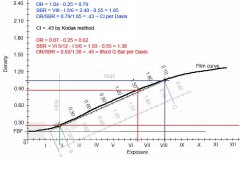First of all Michael /OP isn't totally wrong on his concept of blank film and CI. He is just being extreme in the example. People shouldn't be so quick to jump on the trash OP wagon. Sandy's reprimand of OP's use of proper technical terms can be applied to himself. SBR is an out of date and inappropriate term. Brightness is a subjective term and has not been used since the 1950s or 60s. The correct term is Luminance Range which is psychophysical. The abbreviation is generally LSLR. You can also us log-H Range when referring to the characteristic curve.
If anyone is interested in an authoritative discussion of Contrast Index, there is a paper, Niederpruem, C.J., Nelson, C.N., and Yule, J.A.C, Contrast Index, Photographic Science and Engineering, Vol. 10, N. 1, Jan-Feb 1966.
Davis is also mistaken as to Ilford's average gradient. There isn't an arc. It is a perpendicular line rising from the 1.50 log-H line emanating from 0.10 over film base plus fog. Ilford established this approach in the early 50s. The log-H range of the line comes from the range used in the fractional gradient method. Kodak's CI "floating" toe anchor point is also related to the fractional gradient method.
The range of the log-H line is designed to reflect the useful log-H range of the curve. It reflects either the average LSLR - flare or in the case of CI, the arc basically reflects the changing effective log-H range as the contrast increases. The 1.50 range of Ilford was accurate with the old non coated lens and the higher flare factors. Today, average flare is lower, so CI is the most accurate approach. The difference is mostly seen with long toed curves. It also becomes more apparent with film developed to higher contrasts.
It took me a little while to figure out the discrepancy between Adams target 1.25 to 1.35 DR for a grade two paper and ANSIs 0.95 to 1.15 DR until I realized it was all about flare. Think about it.






